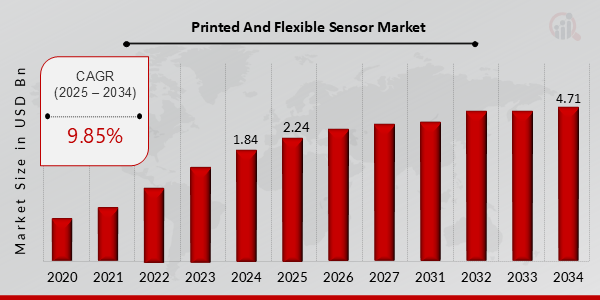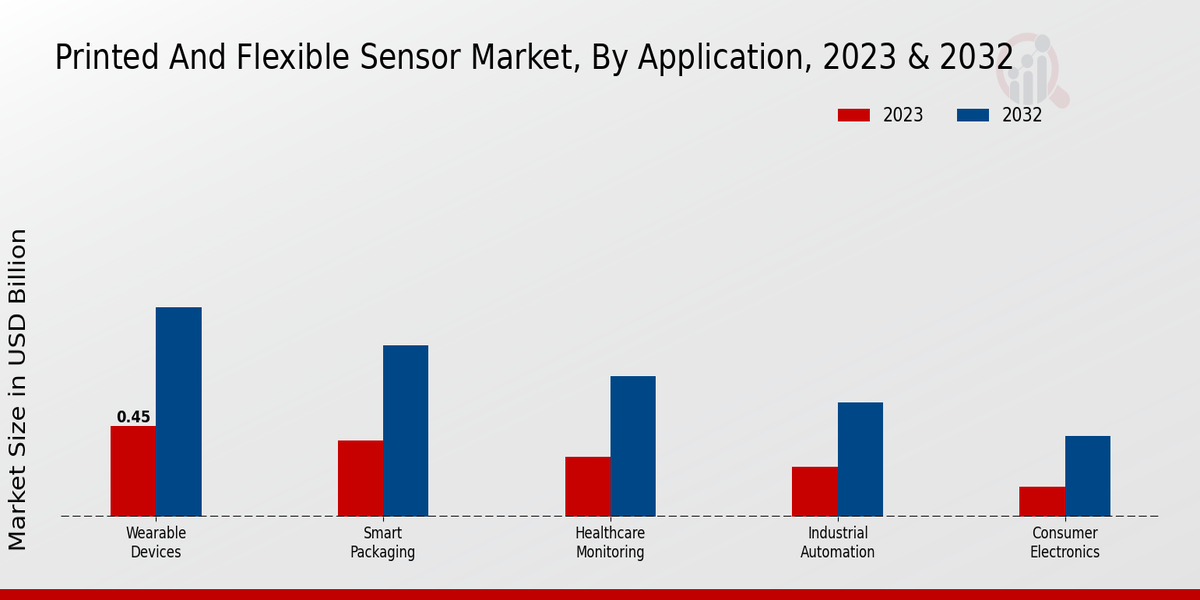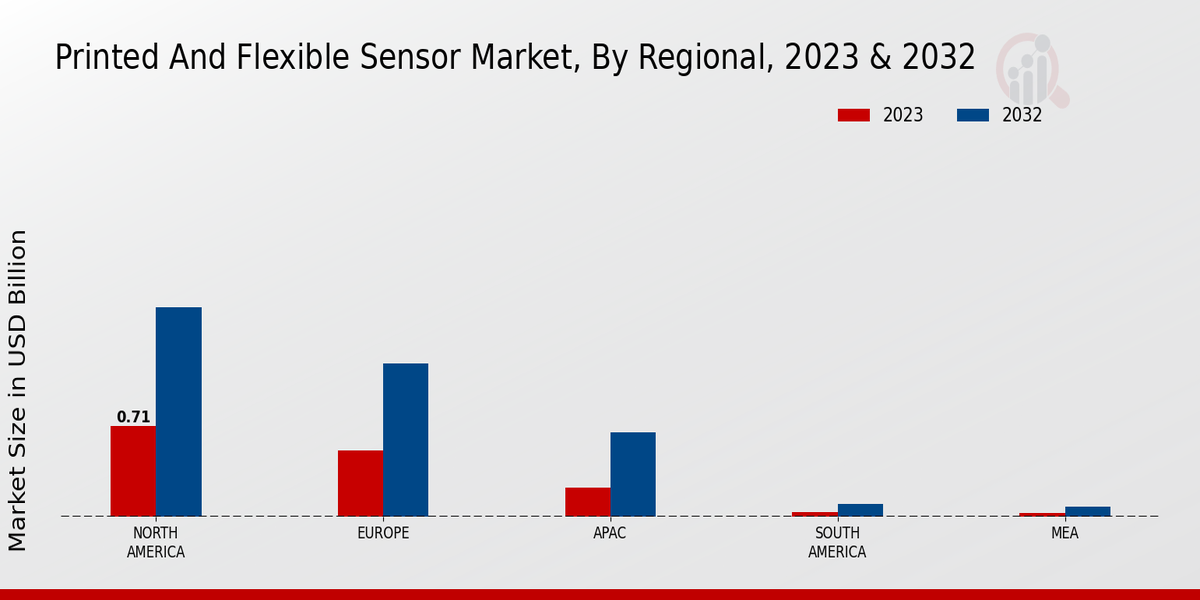Global Printed and Flexible Sensor Market Overview:
Printed And Flexible Sensor Market Size was estimated at 1.84 (USD Billion) in 2024. The Printed And Flexible Sensor Market Industry is expected to grow from 2.24 (USD Billion) in 2025 to 4.71 (USD Billion) till 2034, exhibiting a compound annual growth rate (CAGR) of 9.85% during the forecast period (2025 - 2034).
Key Printed and Flexible Sensor Market Trends Highlighted
The Printed and Flexible Sensor Market is driven by various factors, including the increasing demand for wearable devices, the rise of the Internet of Things, and advancements in sensor technology. Wearable devices, including smartwatches and fitness trackers, have become commonplace, leading to a significant push for lightweight, flexible sensors that can be seamlessly integrated into different applications. Additionally, as industries move towards automation and smart systems, the need for efficient sensor solutions that can provide real-time data is becoming paramount. The growth in healthcare and the increasing focus on remote patient monitoring also contribute to market expansion, making printed sensors a popular choice due to their cost-effectiveness and adaptability.Several opportunities can be explored in this evolving market.
One significant opportunity lies in the development of sensors tailored for specific industry needs, such as healthcare and automotive sectors. As technology continues to advance, there is also potential for integrating these sensors with machine learning and AI applications to enhance data analysis capabilities. The growing trend towards sustainability presents another promising avenue, as printed and flexible sensors can be manufactured using eco-friendly materials, appealing to environmentally conscious consumers. Recent times have seen noticeable trends in the market, particularly the shift towards miniaturization of sensors and increased demand for multifunctional capabilities.Manufacturers are increasingly focusing on integrating various sensing functions into a single device, enhancing usability and functionality.
Smart textiles that incorporate sensors for health monitoring and environmental sensing are gaining traction, reflecting a broader trend towards smart living solutions. As industries adapt to changing consumer needs, the printed and flexible sensor market is likely to evolve, with ongoing innovation playing a pivotal role in shaping its future.

Source: Primary Research, Secondary Research, MRFR Database and Analyst Review
Printed and Flexible Sensor Market Drivers
Increasing Demand for Wearable Technology
The Printed and Flexible Sensor Market Industry is experiencing significant growth driven by the increasing demand for wearable technology. As consumers become more health-conscious, there is a rising need for devices that can monitor vital signs and physical activity. Printed and flexible sensors are an ideal fit for wearables due to their lightweight, flexible nature, which allows for comfortable and unobtrusive use. This growth is further fueled by advancements in sensor technology that enable more accurate and reliable data collection.Wearable devices can integrate these sensors seamlessly, providing users with real-time health data and enhancing their overall lifestyle. The trend is particularly pronounced in sectors such as fitness, healthcare, and sports, where monitoring performance and health metrics is essential.
Additionally, the proliferation of smartwatches and fitness bands is contributing to market expansion. As manufacturers continue to innovate and introduce new features, the demand for printed and flexible sensors is expected to escalate.Furthermore, the integration of sophisticated software solutions with these sensors enhances their functionalities, making them more appealing to consumers. The growing popularity of the Internet of Things (IoT) is another factor driving wearable technology's advancement, as connected devices increasingly leverage printed and flexible sensors for enhanced performance and data collection capabilities. This technological synergy is compelling manufacturers to invest in research and development, thereby driving the overall growth of the Printed and Flexible Sensor Market Industry.
Rising Application in Healthcare
The application of printed and flexible sensors in the healthcare sector is a strong driver for the Printed and Flexible Sensor Market Industry. As healthcare continues to evolve towards more personalized and remote monitoring approaches, these sensors play a pivotal role in enabling advanced medical devices. They allow for non-invasive monitoring of various health parameters, providing critical data that can lead to timely medical interventions.The increasing prevalence of chronic diseases and the need for continuous patient monitoring are driving the adoption of these sensor technologies. Additionally, the pandemic has accelerated the demand for remote healthcare solutions, further highlighting the importance of printed and flexible sensors.
Technological Advancements
Technological advancements in manufacturing processes and materials used for printed and flexible sensors are propelling the growth of the Printed and Flexible Sensor Market Industry. Innovations in printing techniques, such as inkjet and screen printing, allow for cost-effective production of highly sensitive sensors. New materials, including conductive polymers and nanomaterials, enhance the performance and functionality of these sensors, making them suitable for a wider range of applications.As research continues to evolve, the capabilities of printed and flexible sensors are expanding, leading to a greater variety of applications across different industries. This continuous progress supports both the introduction of new products and the improvement of existing solutions, promoting long-term growth in the market.
Printed and Flexible Sensor Market Segment Insights:
Printed and Flexible Sensor Market Application Insights
The Application segment of the Printed and Flexible Sensor Market showcases diverse utilization across various industries, contributing significantly to the market's growth and innovation. In 2023, the Wearable Devices segment alone was valued at 0.45 USD Billion, and it is expected to grow to 1.04 USD Billion by 2032, demonstrating its major role in the adoption of health and fitness tracking features in consumer products. Smart Packaging followed closely, with a valuation of 0.38 USD Billion in 2023 and an expected increase to 0.85 USD Billion by 2032, marking it as a significant segment due to the rising demand for enhanced product tracking and consumer safety.The Healthcare Monitoring segment had a value of 0.30 USD Billion in 2023, forecasted to reach 0.70 USD Billion by 2032, indicating its vital importance in remote patient monitoring and personalized medicine.
Furthermore, Industrial Automation is also becoming increasingly pivotal, valued at 0.25 USD Billion in 2023 and anticipated to expand to 0.57 USD Billion by 2032, which highlights the ongoing evolution in efficiency, safety, and reliability of manufacturing processes. Lastly, the Consumer Electronics segment represented the smallest share at 0.15 USD Billion in 2023, with a projection to grow to 0.40 USD Billion by 2032, reflecting its emerging opportunities within innovative consumer devices.Overall, variations within the Printed and Flexible Sensor Market segmentation signal substantial growth potential, driven by technology advancements, increasing consumer expectations, and evolving industrial needs. Each segment of application not only represents unique growth drivers but also poses distinct challenges and opportunities within this dynamic marketplace.

Source: Primary Research, Secondary Research, MRFR Database and Analyst Review
Printed and Flexible Sensor Market Sensor Type Insights
The Printed and Flexible Sensor Market is projected to achieve significant revenue growth, with the market valued at 1.53 Billion USD in 2023 and expected to expand to 3.56 Billion USD by 2032. This dynamic growth is driven by advancements in technology and increasing applications across various industries. The segmentation of the market by Sensor Type reveals key players such as Pressure Sensors, Temperature Sensors, Light Sensors, Touch Sensors, and Chemical Sensors, each contributing uniquely to the market landscape. Pressure Sensors dominate in sectors like automotive and healthcare for monitoring vital conditions, while Temperature Sensors are crucial in industrial and consumer applications, ensuring operational efficiency.
Light Sensors play a significant role in enhancing energy efficiency in smart lighting systems, whereas Touch Sensors are increasingly important in consumer electronics, providing user-friendly interfaces. Chemical Sensors are essential in environmental monitoring and safety applications, addressing the need for real-time data. The continuous innovation in these sensor types is facilitating the exploration of new applications and operational efficiencies, further propelling the Printed and Flexible Sensor Market growth.
Printed and Flexible Sensor Market Material Insights
The Printed and Flexible Sensor Market, valued at 1.53 USD Billion in 2023, showcases diverse materials that enhance sensor capabilities. The material segment comprises several key categories including Conductive Polymers, Metal Prints, Nanomaterials, Organic Electronics, and Graphene-Based Materials, each contributing uniquely to market growth. Conductive Polymers are increasingly popular due to their flexibility and lightweight nature, making them suitable for various applications. Metal Prints provide excellent electrical conductivity, essential for high-performance sensors in demanding environments.Nanomaterials are crucial as they enable miniaturization and improved sensor sensitivity. Organic Electronics are gaining traction with their potential to lower production costs and enhance device flexibility.
Meanwhile, Graphene-Based Materials are recognized for their remarkable electrical properties, driving innovations in sensor design. The increasing demand for wearable technology and the Internet of Things (IoT) are significant growth drivers for these materials, supported by the Printed and Flexible Sensor Market segmentation statistics that highlight their importance.However, challenges such as material stability and manufacturing complexity remain, presenting opportunities for further development and innovation in this rapidly evolving industry.
Printed and Flexible Sensor Market End Use Industry Insights
The Printed and Flexible Sensor Market is valued at 1.53 Billion USD and is poised for significant growth, reaching 3.56 Billion USD by 2032, showcasing the expanding applications of printed and flexible sensors in various sectors. Within the End Use Industry, key areas include Healthcare, Automotive, Consumer Electronics, Food Beverage, and Retail, each contributing uniquely to market growth. The Healthcare sector significantly drives demand, leveraging sensors for diagnostics and patient monitoring, while the Automotive industry benefits from enhanced vehicle performance and safety through flexible sensing technologies.
Consumer Electronics remain a dominant force as consumers seek innovative devices equipped with advanced sensors for an improved user experience. The Food Beverage sector relies on sensors to ensure quality and safety standards, whereas Retail increasingly adopts these technologies for inventory management and customer engagement, indicating a shift towards automation. Overall, the Printed and Flexible Sensor Market shows promising trends fueled by advancements in technology and the desire for smarter applications across various industries, highlighting the importance of sensor integration in modern solutions and the potential for enhanced efficiency and safety measures in everyday operations.
Printed and Flexible Sensor Market Regional Insights
The Printed and Flexible Sensor Market revenue demonstrates a growing trend across various regions, with North America holding the majority position valued at 0.71 USD Billion in 2023, projected to grow to 1.63 USD Billion in 2032. This dominance is attributed to advancements in technology and a robust demand in industries such as healthcare and consumer electronics. Europe follows as a significant area, with its market valued at 0.52 USD Billion in 2023, anticipated to reach 1.19 USD Billion by 2032, reflecting a strong emphasis on innovation and sustainability in manufacturing processes.
The APAC region, while currently valued at 0.23 USD Billion in 2023 and expected to climb to 0.66 USD Billion in 2032, is gaining traction due to increasing industrial applications and investments in smart technologies. South America and MEA, valued at 0.04 USD Billion and 0.03 USD Billion respectively in 2023, represent emerging markets with growth potential, driven by rising awareness of smart sensor applications. Although smaller in scale, these regions are gradually growing as technological adoption increases, presenting opportunities for market expansion and diversification.

Source: Primary Research, Secondary Research, MRFR Database and Analyst Review
Printed and Flexible Sensor Market Key Players and Competitive Insights:
The Printed and Flexible Sensor Market is characterized by rapid technological advancements and an increasing demand for innovative sensing solutions across various industries. As the market evolves, competition intensifies with numerous players striving for dominance by focusing on product innovation, strategic partnerships, and expansions in emerging markets. The integration of printed electronics technology has led to the development of cost-effective and lightweight sensors, widening their application in consumer electronics, healthcare, automotive, and industrial automation sectors. This dynamic environment has fostered a trend toward integrating flexible and printed sensors into a diverse range of products, enhancing functionality and user experience. Players in this market face the challenge of balancing performance, adaptability, and costs to meet the growing requirements for sustainable and efficient sensing technologies.
Vishay Intertechnology has established a formidable presence in the Printed and Flexible Sensor Market, leveraging its extensive experience in passive components and semiconductor technology to offer robust solutions. The company's strengths lie in its research and development capabilities, which facilitate the creation of high-performance printed sensors tailored for various applications. Vishay Intertechnology is recognized for its commitment to quality and reliability, which positions it favorably against competitors in industries such as automotive and healthcare. With a solid base of intellectual property and patented technologies, the company is able to continuously innovate and deliver value-added features in its printed sensor offerings. This focus on quality and innovation reinforces its competitive edge, enabling it to cater to the evolving needs of clients seeking advanced sensing solutions.Omron is another key player in the Printed and Flexible Sensor Market, known for its innovative approach to sensing technology.
The company has a well-rounded portfolio that includes various types of sensors designed for flexibility and ease of integration into diverse environments. Omron capitalizes on its extensive experience in creating automation solutions, allowing it to integrate its printed sensors seamlessly into its broader product lineup. The company's strengths include a strong emphasis on research and development, enabling them to stay ahead of technological trends and market demands. Omron's commitment to sustainability and energy-efficient solutions has made it a preferred choice for industries looking to reduce their ecological footprint. This focus not only enhances the company's market reputation but also solidifies its competitive stance in the ever-evolving landscape of printed and flexible sensors.
Key Companies in the Printed and Flexible Sensor Market Include:
-
Vishay Intertechnology
-
Omron
-
Konica Minolta
-
Amphenol
-
Texas Instruments
-
STMicroelectronics
-
Honeywell
-
Elbit Systems
-
Paragon Technologies
-
DOW Chemical
-
Bosch
-
NXP Semiconductors
-
FLEXcon
-
3M
-
Thinfilm Electronics
Printed and Flexible Sensor Industry Developments
Recent developments in the Printed and Flexible Sensor Market have highlighted significant advancements and trends. Companies like Vishay Intertechnology, Omron, and STMicroelectronics are focusing on innovative solutions to enhance sensor capabilities, particularly in IoT applications and wearable technology. Current affairs indicate a rising interest in eco-friendly materials, with companies like DOW Chemical and Bosch investing in sustainable sensor production methods. Notably, merger and acquisition activity has been evident, with Amphenol acquiring new sensor technologies to expand its portfolio, and Honeywell exploring partnerships to diversify its sensor applications. Furthermore, companies like 3M and Thinfilm Electronics are experiencing growth in market valuation due to their commitment to RD and advancements in flexible sensor technologies, which are shaping applications across healthcare, automotive, and industrial sectors. The competitive landscape is evolving as firms pursue strategic alliances to bolster technological capabilities, reflecting a rapidly changing market that is driven by innovation and demand for versatile sensor solutions.
Printed and Flexible Sensor Market Segmentation Insights
Printed and Flexible Sensor Market Application Outlook
- Wearable Devices
- Smart Packaging
- Healthcare Monitoring
- Industrial Automation
- Consumer Electronics
Printed and Flexible Sensor Market Sensor Type Outlook
- Pressure Sensors
- Temperature Sensors
- Light Sensors
- Touch Sensors
- Chemical Sensors
Printed and Flexible Sensor Market Material Outlook
- Conductive Polymers
- Metal Prints
- Nanomaterials
- Organic Electronics
- Graphene-Based Materials
Printed and Flexible Sensor Market End Use Industry Outlook
- Healthcare
- Automotive
- Consumer Electronics
- Food Beverage
- Retail
Printed and Flexible Sensor Market Regional Outlook
- North America
- Europe
- South America
- Asia Pacific
- Middle East and Africa
|
Report Attribute/Metric
|
Details
|
|
Market Size 2024
|
USD 1.84 Billion
|
|
Market Size 2025
|
USD 2.24 Billion
|
|
Market Size 2034
|
USD 4.71 Billion
|
|
Compound Annual Growth Rate (CAGR)
|
9.85% (2025-2034)
|
|
Base Year
|
2024
|
|
Market Forecast Period
|
2025-2034
|
|
Historical Data
|
2020-2023
|
| Market Forecast Units |
USD Billion |
| Key Companies Profiled |
Vishay Intertechnology, Omron, Konica Minolta, Amphenol, Texas Instruments, STMicroelectronics, Honeywell, Elbit Systems, Paragon Technologies, DOW Chemical, Bosch, NXP Semiconductors, FLEXcon, 3M, Thinfilm Electronics |
| Segments Covered |
Application, Sensor Type, Material, End Use Industry, Regional |
| Key Market Opportunities |
Wearable health monitoring solutions, Smart packaging applications, Automotive sensor integration, IoT-enabled smart devices, Sustainable manufacturing practices |
| Key Market Dynamics |
Technological advancements, Growing demand for wearables, Cost-effective manufacturing processes, Increasing applications in healthcare, Environmental sustainability initiatives |
| Countries Covered |
North America, Europe, APAC, South America, MEA |
Frequently Asked Questions (FAQ) :
The Printed and Flexible Sensor Market is expected to be valued at 4.71 USD Billion by 2034.
The expected CAGR for the Printed and Flexible Sensor Market from 2025 to 2034 is 9.85%.
Wearable Devices is projected to hold the largest market share, valued at 1.04 USD Billion by 2032.
The market size for Smart Packaging is projected to reach 0.85 USD Billion by 2032.
The North American market for Printed and Flexible Sensors is expected to be valued at 1.63 USD Billion by 2032.
The estimated value of the Consumer Electronics segment is expected to reach 0.4 USD Billion by 2032.
Key players in the market include Vishay Intertechnology, Omron, Konica Minolta, and Honeywell, among others.
The expected market value for Healthcare Monitoring is projected to be 0.7 USD Billion by 2032.
The Industrial Automation segment is anticipated to grow to a value of 0.57 USD Billion by 2032.
The APAC region is expected to be valued at 0.66 USD Billion by 2032.

















